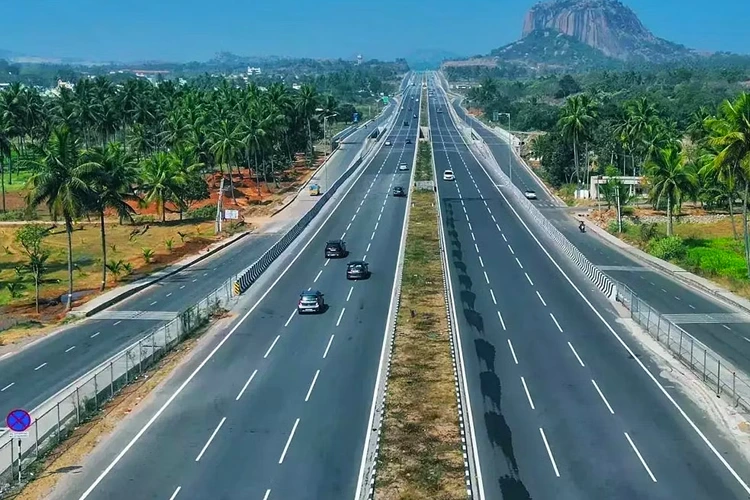Atal Setu or the Mandovi River Bridge, a dream project of Goa Chief Minister Manohar Parrikar is expected to decongest Panaji traffic and serve as a bypass for those who want to travel from north to south without entering Panaji.
Bengaluru - Mysuru Expressway
Read Time: 5 minutes
click play to listen to the article
Prime Minister Narendra Modi on 12 March 2023 inaugurated and dedicated the Bengaluru-Mysuru Expressway to the nation. Built at a cost of INR 8,478 crore, Bengaluru-Mysuru Expressway has been constructed as a six-lane stretch, along with two-lane service roads on either side of the expressway, making it a 10-lane corridor. The 118 km long access-controlled expressway is a part of Modi Government’s flagship Bharatmala Pariyojana under which implementation of 34,800 km of national highways in 5 years was approved at an estimated outlay of INR 5,35,000 crores. Reducing the commute time between Bengaluru & Mysuru from 3.5-4 hours to approximately 75 mins, the access-controlled highway is a gift to the country.
The Bengaluru-Mysuru Expressway bypasses some of the most crowded towns and biggest traffic bottlenecks, such as Mandya or Maddur. Now a trip from Bengaluru to Ooty, arguably the most popular hill station in South India, can be covered in 4.5 hours from what used to take almost 7 hours. Likewise, Wayanad, another popular tourist destination in Kerala, can now be covered in 4 hours, as against the earlier 6 hours. In future, Mangalore too could be reached in a shorter duration since NH-275 will be developed all the way to Bantwal-BC Road Junction. Similarly, travel time to Coorg has been reduced to 3.5 hours from earlier 6 hours; Kozhikode to 5.5 hours from earlier 8 hours; Kannur to 5 hours from earlier 7 hours; Bandipur to 3.5 hours from earlier 5.5 hours and Nagarhole to 3 hours from earlier 5 hours.
The Bengaluru-Mysuru Expressway project consists of two phases: a 58 km-long Phase 1 between Bengaluru and Nidaghatta, and a 61 km-long Phase 2 between Nidaghatta and Mysore. In addition, it also comprises greenfield sections that form bypasses around Bidadi (7 km), Ramanagara-Channapatna (22 km), Maddur (7 km including 3.5 km of elevated highway), Mandya (10 km) and Srirangapatna (7 km). The Bengaluru-Mysuru Expressway has elevated corridors that are 8 km long, 9 major bridges, 40 small bridges, 89 underpasses, 11 overpasses, four Road-Over-Bridges (ROBs), and five bypasses. Bikes, autos and other slow-speed vehicles will not be allowed on the expressway.
The Bengaluru – Mysuru Expressway would see several new technology innovations for the first time in the country. These include global-standard infrastructure, a mixture of greenfield and brownfield, and dedicated lanes for rural and urban traffic.
Road connectivity between economic centres opens up jobs, new businesses and new markets. The Mumbai – Pune Expressway had demonstrated this already for western Maharashtra. The Bengaluru – Mysuru Expressway will similarly bring further abundance to Karnataka. With NH-275 being developed, even Mangaluru port will become closer to Mysuru. The Modi government plans to set up a crafts village/clusters similar to Delhi Haat along the expressway to create opportunities for Channapatna toys artisans. The 30-acre area to be built at a cost of INR 1,200 crores will have restrooms, restaurants, eateries, kiosks and stalls for Channapatna’s wooden toys, dolls and wares that were conferred with the GI tag. It would also have electric vehicle charging stations, fuel stations, and gas stations.
The Bengaluru-Mysore Expressway is a testament of Modi government’s commitment to improving transportation infrastructure in the country. Better roads lead to bigger growth and connectivity. Improved connectivity between Bengaluru and Mysore is likely to lead to increased business opportunities and tourism in the area. This, in turn, is expected to create jobs and boost the local economy. The expressway will totally change the travel dynamics and economics in South India.
Tags: The New India, Infrastructure
Share this article:
Leave a Comment
Recommended For You
In a historic moment for India, Prime Minister Narendra Modi flagged off MV Ganga Vilas, the world's longest river cruise which makes a journey through India and Bangladesh, showcasing the rich heritage and culture of both countries.
The Bogibeel bridge over the Brahmaputra will boost defence logistics along the China border and increase the economic activity of the long-time neglected Northeast region.
The Bengaluru-Mysore Expressway is a testament of Modi government's commitment to improving transportation infrastructure in the country. Improved connectivity between Bengaluru and Mysore is likely to lead to increased business opportunities and tourism in the area.
India's first semi-high speed train, the Vande Bharat Express, was launched by Prime Minister Modi on 15 February 2019. The train offers Indian travelers a myriad of superior amenities and provides passengers with aircraft like travelling experience.
India's widest and second largest cable-stayed bridge in India, the Zuari bridge in Goa will enhance the economic activity of the state.
Fast-tracked by Narendra Modi, besides supporting the Armed Forces, the Atal Tunnel is destined to play a defining role in the future development of the region.















